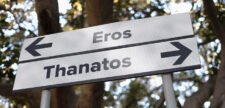Transylvania I – a travel blog
Transylvania. The name immediately evokes weird, scary stuff.
My friend, Trish, has a daughter, Caroline, who went on a talk show for kids in New York City when she was 3 years old. Somehow the subject of vampires came up, whereupon Caroline informed the host that, “Vampires comes from Pennsylvania.”
Trish came to visit me in Romania last week, and we went to the real place where vampires come from, namely Transylvania.
Hold on. There are no real vampires, although stories about them abound, starting in Western fiction with John Polidori’s The Vampyre (1819), continuing with Bram Stoker’s Dracula (1897) and up through (but likely not ending with) the HBO Series True Blood (2008-2014 – not set in Transylvania, I know).
In order to write about Transylvania in any reasonable way, I first have to cut through the pop culture image of it as the place where vampires live and (delightfully) creepy weird stuff happens.
For example, there’s the song “Sweet Transvestite from Transsexual Transylvania” from The Rocky Horror Picture Show:
Then there’s the muppet Count von Count along with the breakfast cereal Count Chocula, not to mention the animated Hotel Transylvania and Hotel Transylvania 2 that spawned McDonald’s Happy Meal toys, plus a Simpson’s Halloween special set in Transylvania I couldn’t find on YouTube.
All rightie, then.
Stoker got things going in Romania. He designated Bran Castle, which is a short drive from the Transylvanian town of Braşov, as the place his title character lived – or where he had his coffin – or something like that. The castle is currently owned by the Archduke of Habsburg who got it back from the Romanian state after the Communists confiscated it from his relatives in 1948. It’s a museum and a major tourist attraction.
Here’s a video:
Trish and I went to Bran on a beautiful Sunday afternoon. The atmosphere was like a carnival, with tons of booths selling Romanian souvenirs and a ghoul walking around on stilts.

The castle was packed, wall-to-wall people, so many it was difficult to make it through.
So who is Dracula? Drac in Romanian means ‘devil’, and dracul means ‘the devil.’ Bram Stoker based his fictional Dracula on the 15th-century historical Romanian figure Vlad Țepeș:

His nickname derives from țep (or țeapă), which means ‘stake,’ making his English name Vlad the Impaler. He was, in fact, known to impale people on stakes:

The Dracula story is further infused with Romanian mythological creatures known as strigoii, troubled souls of the dead who leave their graves at night and turn into fantastical creatures who do bad things to the living. Blood sucking fits right in.

The myth of the strigoii apparently goes back to the Dacians, the pre-Roman and certainly pre-Christian people who once inhabited present-day Romania.
So the formula appears to be: Vlad Țepeș + a strigoi = Dracula.
So what’s the deal with the garlic?

I found the following at the Garlic Central website:
“Vampirism can be seen as symbolic of mosquito bites – and garlic is known in folklore as a natural mosquito repellent.
“Mosquitoes suck blood and in doing so spread disease. So do vampires. Some of the symptoms of malaria – exhaustion, fever, anemia – are reminiscent of the reputed effects of being bitten by a vampire without being totally drained or turned. Garlic is a known insect repellent which reportedly works well against mosquitoes, perhaps people saw the similarity with vampires, especially when in their bat form.”
Sounds reasonable – and speaking of bats, one Transylvanian winery has embraced the legend and chosen its brand name to be Liliac ‘bat’ (also, incidentally ‘lilac’). When I saw it on a menu, I had to get it. Here’s me having a glass of Bat Fetească Regală (a dry white wine grape) in Braşov:
When we got back to Bucharest, we took a walk around Lake Herăstrău, and sure enough at a lakeside restaurant we stopped in for lunch, we got Bat wine again, this one a Sauvingon Blanc.


Lake Herăstrău is in the background
Note on garlic: If you’re experiencing hair loss, rub slivers of garlic on your scalp then wrap your head in plastic and leave it for an hour and a half at most. Any longer and you’ll burn your scalp. Do this twice a week. Within three months you’ll see your first tiny hairs sprout up. You have to continue the treatment. Upside: it’s nearly free and completely natural. Downside: the smell. You’ll need to wash your hair at least three times after each treatment. I heard of this from a Romanian woman who says it works for her.
All in all, then, Transylvania is the designated place on earth for people to project their visions of blood-sucking vampires and other creepy crawly horrors with all their shivery delights.
See also: Transylvania II
Categorised in: Adventure, Europe, Romania
This post was written by Julie Tetel Andresen
You may also like these stories:
- google+
- comment



